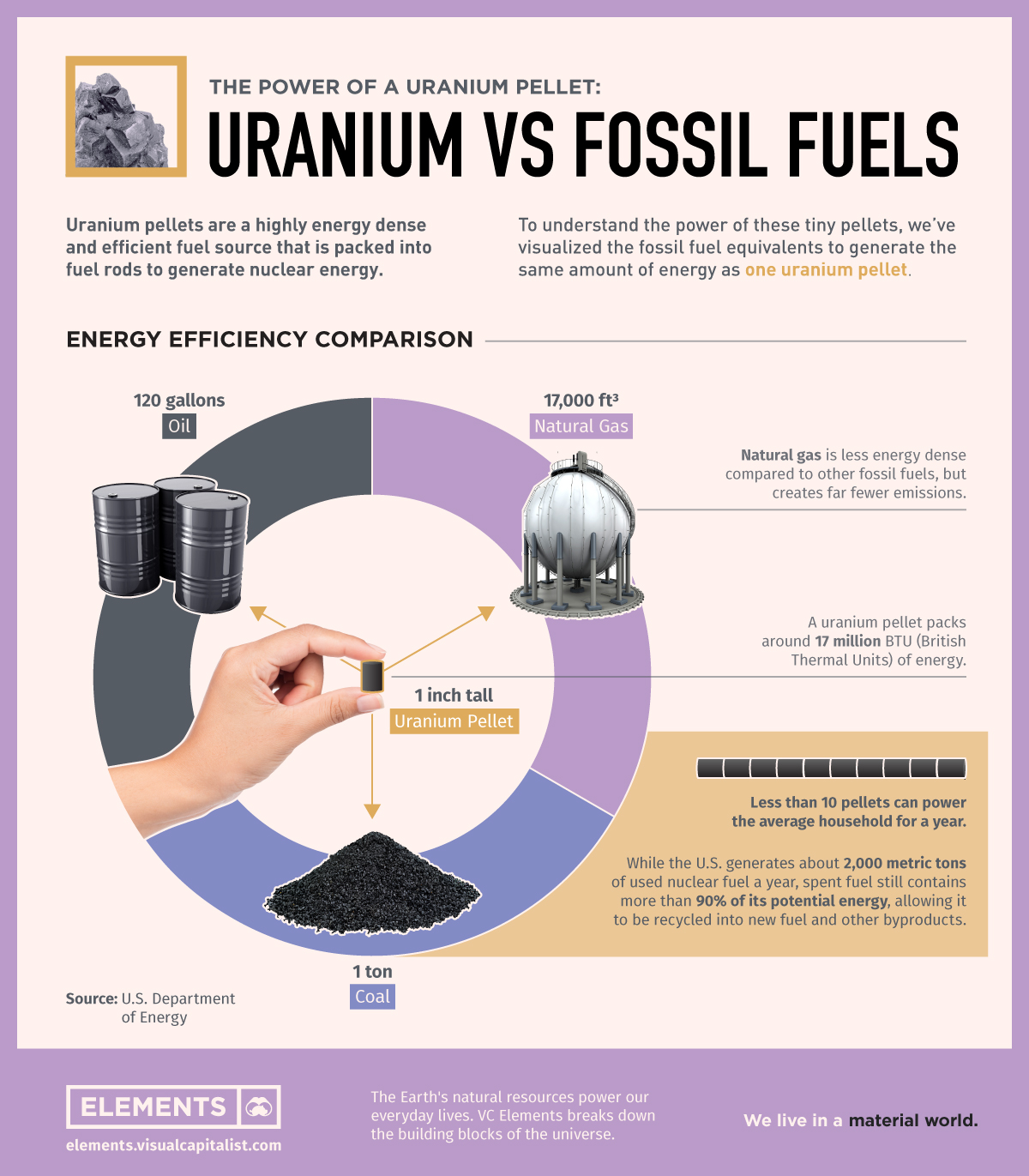The power of a uranium pellet

The energy efficiency of a uranium pellet
Nuclear energy’s incredible efficiency and powerful nature comes from uranium’s high energy density.
It is the most energy dense and efficient fuel source we have, with just ten uranium pellets able to power the average household for an entire year.
Using research from the U.S. Department of Energy, this graphic puts in perspective the efficiency of a single uranium pellet in comparison to fossil fuels.
Uranium’s energy density vs. fossil fuels
Uranium’s energy efficiency comes from it’s highly dense atomic and material nature, which is split apart when nuclear fission occurs.
It is the second-heaviest metal in terms of relative atomic mass, and is also one of the densest at around 19 g/cm3. For context, a gallon of milk weighs around 8 lbs, while a same-sized container of uranium would weigh around 150 lbs.
In the process of nuclear fission, the U-235 isotope of uranium is hit by a moving neutron and splits in two. This splitting of the atom produces heat energy and releases more neutrons that hit other U-235 atoms, causing a chain reaction of nuclear fission.
The energy generated by the fission of a single uranium pellet is equivalent to:
- 1 ton of coal or
- 120 gallons of crude oil or
- 17,000 ft3 of natural gas
With about 17 million British Thermal Units (BTU) worth of energy in a uranium pellet, it’s no wonder that many are now looking at nuclear energy as a key piece to the clean energy puzzle.
Not just better than fossil fuels
Nuclear power isn’t just an improvement over fossil fuels, it also beats out renewable energy sources in a few other key areas. Along with low lifecycle emissions, nuclear power also has a low land footprint and the highest reliability compared to other sustainable energy sources.
1. CO2 Lifecycle Emissions
As a non-fossil fuel source of energy, nuclear power has one of the lowest average life cycle CO2 emissions among energy technologies. Since 1970, nuclear power plants have reduced over 60 gigatonnes of CO2 emissions, and have lower average life cycle emissions compared to solar panels, geothermal energy, and hydropower.
2. Land Footprint
While reducing carbon emissions is great, renewable energy sources are also judged on their land footprint. Nuclear power has one of the lowest land footprints per 1,000 megawatts of electricity a year at 1.3 square miles. In comparison, for the same amount of energy solar power requires ~75x more surface area, and wind power requires ~360x more surface area.
3. Power Generation Uptime
The power generation uptime of energy sources is another important metric to measure their reliability and efficiency. Nuclear power plants have the best uptime of all energy sources, running at maximum capacity 92.5% of the year. In comparison, the two next best energy sources in terms of reliability are geothermal energy (74.3%) and natural gas (56.6%).
Nuclear energy’s water usage and waste disposal
Although nuclear energy is incredibly efficient and much cleaner than fossil fuels, it still isn’t quite a perfect energy solution.
Nuclear power plants rely on large amounts of water especially for their cooling operations, which is why many are located near bodies of water. When compared with other energy sources, many estimates find that nuclear power plants typically consume the most water when using cooling towers.

Along with their water consumption, nuclear power plants also produce nuclear waste which must safely removed and stored in a permanent disposal site.
While countries like France, Germany, and Japan recycle the majority of their spent fuel, the U.S. currently treats it as waste. This results in the spent uranium fuel needing to be cooled for 2-5 years, with the most common cooling method requiring even more water consumption.
Uranium’s future as the world’s energy fuel
While uranium offers an incredible amount of energy in a tiny package, nuclear power is still working to shake off the shadows of past incidents like Fukushima, Three Mile Island, and Chernobyl. Despite this, nuclear still is an incredibly safe energy source compared to fossil fuels, and safety improvements continue to be invested in and researched today.
Nuclear energy is also receiving a fiscal boost in the United States, with the recent infrastructure bill passed by the senate providing funding for two commercial-scale demonstration projects. Just as important, the bill also mentions that when determining whether to certify a reactor, priority will be given to reactors that use uranium that is produced and enriched domestically.
As the world continues working to reduce carbon emissions, people are starting to recognize that uranium’s energy efficiency could be vital in weaning the world off of fossil fuel dependence.
(This article first appeared in the Visual Capitalist Elements)
More News
{{ commodity.name }}
{{ post.title }}
{{ post.date }}

Comments